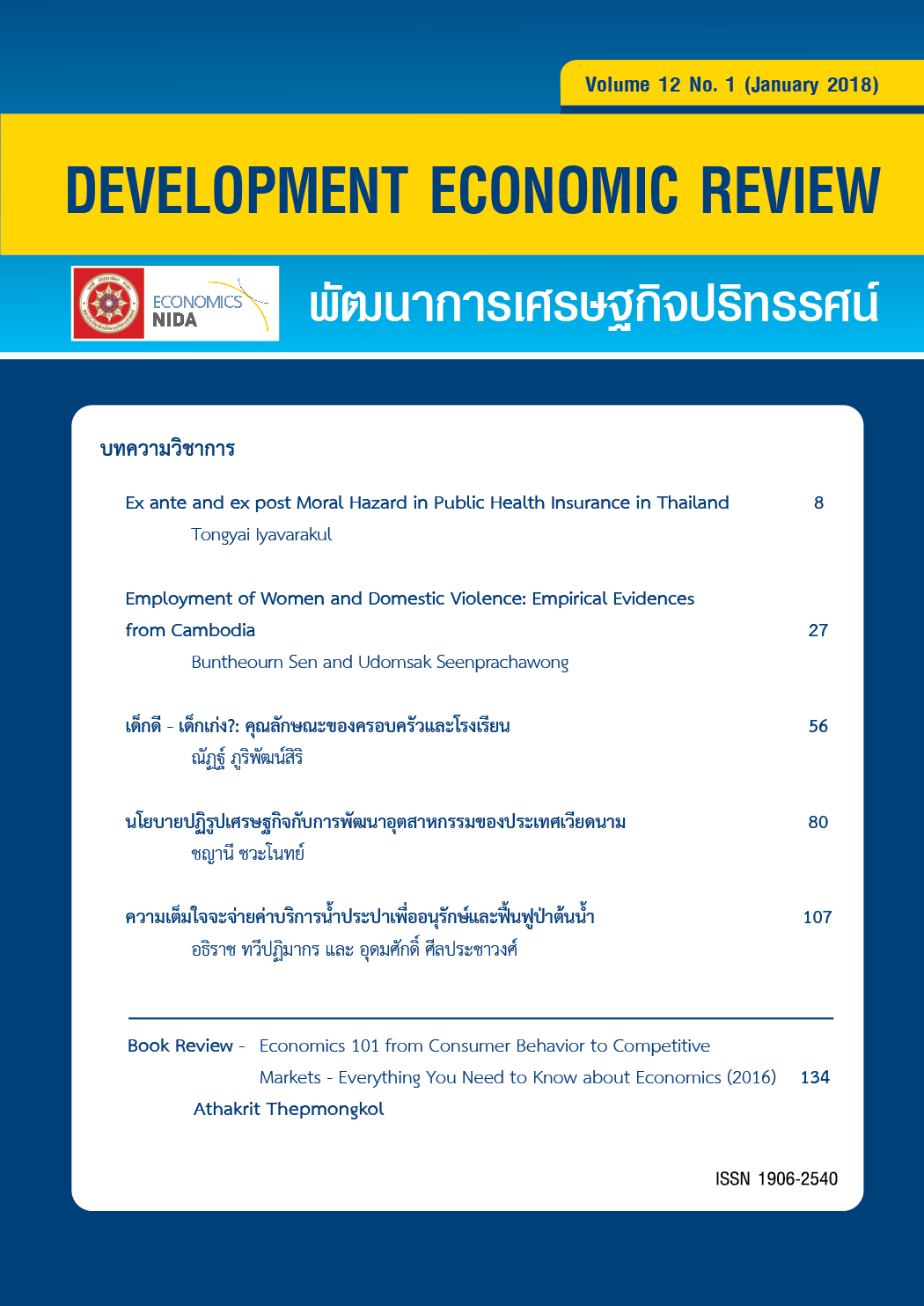Vietnam Economic Renovation Policy and Industrialization
Keywords:
Industrialization, New Structural Economics, VietnamAbstract
This study aims to investigate Vietnam economic renovation policy, Doi Moi, and its effects on Vietnam’s industrialization by applying the New Structural Economics framework that focuses on industrial upgrading with dynamic factors of endowment and supportive soft and hard infrastructure. The Doi Moi policy has substantially changed Vietnam economy into more market-oriented. The analyses, using data from different sources and information from previous studies, show that Vietnam continuously improves its competitiveness and exports more advanced technology products compared to the past 30 years. The main problems, however, are less technology transfers and linkages to local enterprises, as well as lack of skilled labors, resulting in limiting industrialization process. There are still unequal policy implementations among state-owned enterprises, non-state domestic enterprises, and foreign invested enterprises, which are not in line with each group’s performance. Moreover, inadequate and inefficient infrastructure, both physical and institutions, impedes industrialization and results in middle-income trap in the meantime.
References
An Inverted-U Relationship”, Quarterly Journal of Economics,120(2): 701–728.
Alvarez, R., and Claro S. (2008). “David Versus Goliath: The Impact of Chinese Competition
on Developing Countries.” World Development, 37(3): 560–571.
Bodewig, C., Badiani-Magnusson, R., Macdonald, K., Newhouse, D., & Rutkowski, J. (2013).
“Skilling up Vietnam: Preparing the workforce for a modern market economy”, Vietnam
Development Report 2014, Hanoi: World Bank Publications.
CIEM and World Bank (2013), Workforce Development, Vietnam SABER Country Report 2012,
Washington, D.C.: The World Bank
CIEM (2014). Firm-level Technology and Competitiveness in Vietnam Report on Survey 2013.
Doan, T., Nguyen, S., Vu, H., Tran, T., &Lim, S. (2015). Does rising import competition harm
local firm productivity in less advanced economies? Evidence from the Vietnam’s
manufacturing sector, Journal of International Trade and Economic Development,
25(1): 23-46.
Javorcik, B. (2004). “Does foreign direct investment increase the productivity of domestic firms?
In search of spillovers through backward linkages”, American Economics Review,
94(3), 605–627.
Kim, W., Nam, I. C., & Cuong, T. T. (2010).“On the governance of state-owned economic groups
in Vietnam, retrieved from https://ueaeprints.uea.ac.uk/51521/
Lin, Justin (2012) New Structural Economics A Framework for Rethinking Development and
Policy, Washington, D.C.: The World Bank.
Newman, C., Rand, J., Talbot, T.,& Tarp, F. (2015). “Technology transfers, foreign investment
and productivity spillovers”. European Economic Review, 76 (Issue C), 168-187.
OECD. (2016). “Economic Outlook for Southeast Asia, China and India 2016: Enhancing
Regional Ties”, Paris: OECD Publishing.
Perkins, D. H., & Vu-Thanh, T. A. (2010).“Vietnam’s Industrial Policy: Designing Policies for
Sustainable Development. United Nations Development Programme”, retrieved from
https://userpage.fu-berlin.de/~ballou/fama/vietnam/valuechain01.pdf
Thanh, N. X., & Dapice, D. (2008).“Vietnam’s Infrastructure Constraints”, UNDP – Harvard
Policy Dialogue Paper No. 3, Ash Institute for Democratic Governance and Innovation,
Boston: Harvard Kennedy School.
Tran, H. X. (2014). “The evolutions of productivity in Vietnam’s manufacturing sector.”, Doctoral
Dissertation, School of Accounting, Economics and Finance, University of Wollongong,
retrieved from https://ro.uow.edu.au/theses/4444
Tran, A. N. & Norlund, I. (2015).“Globalization, industrialization and labor markets in Vietnam”,
Journal of the Asia Pacific Economy, 20(1),143-163.
Tsuboi, Y. (2007). “Twenty Years After the Adoption of the Doi Moi Policy”. Tokyo: Waseda
University.
UNIDO. (2011). “Viet Nam Industrial Competitiveness Report 2011”, United Nations Industrial
Development Organization and Ministry of Industry and Trade, Viet Nam.
Van, H. T. H. (2012). “Industrial readjustment in Vietnam: Special focus on the new 10 year
socio-economic development strategy for 2011-2020”, Industrial Readjustment in the
Mekong River Basin Countries: Toward the AEC, BRC Research Report, 7.
VDR (2012) “Market Economy for a Middle-Income Vietnam”, Vietnam Development Report
2012, Joint donor report to the Vietnam Consultative Group Meeting.
Vu-Thanh, T. A. (2015). “The political economy of industrial development in Vietnam”.Impact of
State- Business Relationship on Industrial Performance, 1986-2012, GEG Working
Paper 2015/107.
สัมภาษณ์เพิ่มเติม
Ureerat Ratanaprukse, Consul-General, Royal Thai Consulate-General, Ho Chi Minh City.
Tharabodee Serng-Adichaiwit, Senior Vice President and General Manager – Vietnam, Ho Chi
Minh City Branch, Bangkok Bank Public Company Limited.
Asada Boonsrirat, Investment Coordinating Manager, SCG Vietnam Company Limited.
Trinh Nguyen Phuong, Assistant to Investment Coordinating Director, SCG Vietnam Company
Limited.
Suwicha Boonsupa, BJC International Business Division,Berli Jucker Public Company Limited.
Nguyen Thi Tue Anh, Vice President, Central Institute for Economic Management (CIEM),
Ministry of Planning and Investment, Hanoi.
Ngo Minh Tuan, Deputy Director, Central Institute for Economic Management (CIEM), Ministry
of Planning and Investment, Hanoi.
Nguyen Kim-Anh, Director, Center for Information and Documentation, Central Institute for
Economic Management (CIEM), Ministry of Planning and Investment, Hanoi.
Tran Quang Tuyen, Associate Dean, Faculty of Political Economics, VNU University of Economics
and Business, Hanoi.
Hoang Khac Lich, Faculty of Development Economics, VNU University of Economics and Business,
Hanoi.
Dao Vu Phuong Linh, Faculty of Economics and Accounting, Quy Nhon University
Nguyen Thi Thuy Dung, Faculty of Economics and Accounting, Quy Nhon University
Downloads
Published
Issue
Section
License
Copyright to published manuscripts becomes the property of the Graduate School of Development Economics, National Institute of Development Administration. Reproduction of all or part of a Development Economic Review (DER) article by anyone, excluding author(s), is prohibited, unless receiving our permission.
Disclaimer: Opinions expressed in articles published in this journal are those of the author (s) and do nto necessarily represent opinions of the Graduate School of Development Economics, National Institute of Development Administration. Trade and proprietary names are only for identification and not constitute our endorsement.


